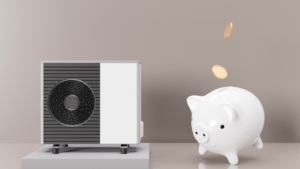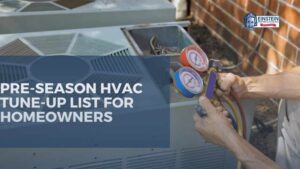If you’ve noticed your furnace leaking water, it can be a cause for concern. A malfunctioning furnace not only compromises your comfort but also poses potential risks. In this detailed guide, we will explore various factors contributing to furnace water leakage and provide practical solutions to address each issue.
Why Is My Furnace Leaking Water?
Condensation Issues
Insufficient Condensate Drainage
- One of the primary reasons for a furnace leaking water is inadequate condensate drainage. High-efficiency furnaces produce condensation during the heating process, which needs to be effectively drained away. If the condensate drain becomes clogged or the drainage system is not functioning correctly, water can accumulate and eventually lead to leaks.
Damaged Condensate Pan
- A damaged condensate pan is another factor contributing to water leakage. The condensate pan is designed to collect excess condensation, preventing it from seeping into the furnace or surrounding areas. If the pan is cracked or compromised, water can escape and cause leakage.
Blocked Drainage System
Clogged Condensate Line
- A clogged condensate line is a common issue that can result in a furnace dripping water. Over time, dust, debris, or algae can accumulate in the condensate line, impeding the flow of water. Regular maintenance, such as cleaning the condensate line, is crucial to prevent clogs and subsequent leaks.
Ice Blockages in the Vent Pipes
- In colder climates, vent pipes may become susceptible to ice blockages. When vent pipes are obstructed by ice, it hinders the proper functioning of the furnace, causing condensation to accumulate and leak. Insulating vent pipes or implementing heating solutions can help mitigate this issue.
Humidity Levels
High Indoor Humidity
- Excessively high indoor humidity levels can contribute to a furnace dripping water. When the air in your home is too humid, it increases the likelihood of condensation forming within the furnace. Monitoring and controlling indoor humidity through the use of dehumidifiers can help prevent this issue.
Inadequate Ventilation
- Poor ventilation in the furnace area can exacerbate humidity-related problems. Insufficient airflow can trap moisture, leading to condensation and eventual water leakage. Ensuring proper ventilation in the furnace space is essential to maintaining optimal conditions.
Furnace Installation Issues
Incorrect Slope of the Vent Pipe
- During installation, the vent pipe should be sloped correctly to facilitate the drainage of condensate. If the vent pipe has an improper slope, water can pool and eventually lead to leaks. Ensuring that the vent pipe is installed at the recommended angle is crucial for preventing this issue. Make sure to get trusted HVAC technicians for your furnace installation.
Improper Furnace Size
- Selecting the right furnace size for your home is crucial for efficient operation. An oversized or undersized furnace can cause various issues, including water leakage. Proper sizing ensures that the furnace operates at its optimal capacity, reducing the likelihood of condensation-related problems.
Malfunctioning Heat Exchanger
Cracked Heat Exchanger
- A cracked heat exchanger is a serious issue that can result in both safety concerns and water leakage. When the heat exchanger develops cracks, it allows water to escape, posing a risk of damage to the furnace and potential exposure to harmful gases. Professional inspection and timely replacement are essential in such cases.
Corrosion of the Heat Exchanger
- Corrosion of the heat exchanger can occur over time, particularly in older furnaces. The presence of rust or corrosion weakens the structure of the heat exchanger, making it more prone to leaks. Regular maintenance and inspections can help identify and address corrosion issues before they escalate.
Air Conditioning Unit Issues
Clogged AC Drain Line
- If your furnace shares a drainage system with the air conditioning unit, a clogged AC drain line can lead to a furnace dripping water. Regular maintenance of both the furnace and the AC unit, including cleaning the drain lines, is crucial for preventing clogs and subsequent leaks.
Refrigerant Leaks
- Refrigerant leaks in the air conditioning unit can impact the furnace as well. When refrigerant leaks occur, it can cause the evaporator coil to freeze, leading to excess condensation. This excess water may find its way into the furnace, resulting in leaks. Addressing refrigerant leaks promptly is essential to prevent such issues.
Leaking Water Supply Line
Loose or Damaged Water Supply Line
- Some furnaces are equipped with a water supply line for humidification purposes. If the water supply line is loose, damaged, or improperly connected, it can lead to water leakage. Checking the condition of the water supply line and ensuring proper installation can prevent this issue.
Faulty Humidifier
- A malfunctioning humidifier attached to the furnace can cause water leaking from the furnace. If the humidifier is not working correctly or if there are issues with its drainage system, it can lead to excess water entering the furnace. Regular maintenance of the humidifier and its components is crucial for preventing leaks.

Troubleshooting Tips for Furnace Water Leaks
1. Condensation Issues
Insufficient Condensate Drainage
- Troubleshooting Tip: Check the condensate drain for clogs or blockages. Use a vacuum or a thin brush to remove any debris obstructing the drain. Ensure that the drain is sloped correctly to facilitate water flow.
Damaged Condensate Pan
- Troubleshooting Tip: Inspect the condensate pan for cracks or damage. If identified, replace the damaged pan to prevent water leakage. Regularly clean the pan to prevent debris buildup.
2. Blocked Drainage System
Clogged Condensate Line
- Troubleshooting Tip: Clear the condensate line by using a mixture of warm water and vinegar or a dedicated condensate line cleaner. Ensure the line is free of obstructions to allow proper drainage. Know how to clean your furnace to avoid issues.
Ice Blockages in the Vent Pipes
- Troubleshooting Tip: Insulate vent pipes in cold climates to prevent ice buildup. If ice is present, carefully thaw it using a hairdryer or warm cloth. Consider adding heat tape or increasing insulation to avoid future occurrences.
3. Humidity Levels
High Indoor Humidity
- Troubleshooting Tip: Use a dehumidifier to regulate indoor humidity levels. Ensure proper ventilation in the home and address any sources of excessive moisture, such as leaky pipes or inadequate sealing.
Inadequate Ventilation
- Troubleshooting Tip: Improve ventilation in the furnace area by ensuring vents are unobstructed. Consider installing additional vents or a fan to enhance airflow and reduce humidity levels.
4. Furnace Installation Issues
Incorrect Slope of the Vent Pipe
- Troubleshooting Tip: Verify the slope of the vent pipe during installation. Adjust the angle if necessary to allow proper drainage. Consult the furnace manual or seek professional assistance for correct adjustments.
Improper Furnace Size
- Troubleshooting Tip: Consult with experienced and certified HVAC technicians from Einstein Pros to determine the appropriate furnace size for your home. If oversized or undersized, consider replacing the furnace with a unit that matches the heating requirements.
5. Malfunctioning Heat Exchanger
Cracked Heat Exchanger
- Troubleshooting Tip: If a cracked heat exchanger is suspected, consult a qualified technician for inspection as this can be a grave cause of water leaking from furnace. Replacement may be necessary, and professional assistance is crucial for ensuring safety.
Corrosion of the Heat Exchanger
- Troubleshooting Tip: Schedule regular maintenance checks to identify and address corrosion issues early. If corrosion is detected, consult a professional HVAC technician to determine the extent of damage and the appropriate course of action.
6. Air Conditioning Unit Issues
Clogged AC Drain Line
- Troubleshooting Tip: Regularly clean the AC drain line to prevent clogs. Flush the line with a mixture of warm water and bleach to remove algae and debris. Consider installing a drain line cleaning device for ongoing maintenance.
Refrigerant Leaks
- Troubleshooting Tip: If refrigerant leaks are suspected, consult an HVAC technician for inspection and repair. Make sure to ask your technician the best questions for furnace repair. Addressing refrigerant issues promptly can prevent subsequent problems with the furnace.
7. Leaking Water Supply Line
Loose or Damaged Water Supply Line
- Troubleshooting Tip: Check the water supply line for any visible damage or loose connections. Tighten connections or replace damaged sections. Regularly inspect the humidifier and its components for proper function.
Faulty Humidifier
- Troubleshooting Tip: Clean and maintain the humidifier regularly. Ensure that the drainage system is functioning correctly. If issues persist, consult the humidifier manual or seek professional assistance.
How to Prevent Furnace Leaking Water
1. Regular Maintenance Checks
Schedule Professional Inspections
- Regular professional inspections by certified HVAC technicians can identify potential issues before they escalate. These experts can thoroughly examine your furnace, including the condensate drain, heat exchanger, and other components prone to leaks. By catching problems early on, you can save both time and money on extensive repairs.
DIY Checks
- Performing routine checks on your furnace is equally important. Keep an eye out for any visible leaks or moisture around the unit and call the experts for furnace repair when needed. Check the condensate drain for clogs and ensure that it is free of debris. Additionally, inspect the heat exchanger for signs of rust or corrosion, as these can contribute to water leakage.
2. Adequate Ventilation
Ensure Proper Airflow
- Inadequate ventilation can cause condensation buildup, leading to water leaks. To prevent this, make sure that the area around your furnace is well-ventilated. Avoid blocking air vents or obstructing the furnace with household items. Proper airflow helps regulate temperature and minimizes the risk of condensation-related leaks.
Monitor Humidity Levels
- Controlling indoor humidity is crucial in preventing condensation. Use a dehumidifier to maintain optimal humidity levels, especially during colder seasons when condensation is more likely to occur. By keeping humidity in check, you can reduce the chances of water accumulating and causing leaks.
3. Condensate Drain Maintenance
Clearing Blockages
- The condensate drain is a common culprit for furnace leaks, especially due to wrong HVAC installation practices. Over time, it can become clogged with dirt, debris, or algae, hindering proper drainage. Regularly clean the drain by flushing it with a mixture of water and vinegar to dissolve any buildup. This simple maintenance task can prevent water from backing up and leaking into your furnace.
Install a Condensate Pump
- Consider installing a condensate pump if your furnace is located in a basement or below ground level. This pump helps move water away from the furnace and prevents it from pooling. By redirecting condensate to a suitable drainage point, you reduce the risk of leaks caused by water accumulation.
4. Seal Potential Entry Points
Inspect Vent Pipe Connections
- Leaks can occur when furnace problems arise, commonly at the point where the vent pipe connects to the furnace. Inspect these connections regularly and ensure that they are securely sealed. Loose or damaged connections can allow water to seep into the furnace, leading to leaks and potential damage.
Check the Flue Pipe
- The flue pipe is another potential entry point for water. Inspect it for any cracks, gaps, or corrosion that may compromise its integrity. Sealing any openings with heat-resistant caulk can prevent water from entering and causing leaks.
5. Monitor and Address Rust or Corrosion
Regular Inspections for Rust
- Rust and corrosion weaken the structural integrity of your furnace, making it susceptible to leaks. Regularly inspect the unit for any signs of rust or corrosion. If you notice any issues, address them promptly by cleaning the affected areas and applying a rust-resistant coating.
Addressing Corroded Heat Exchangers
- The heat exchanger is a critical component of your furnace, and corrosion can lead to water leaks. If you observe corrosion on the heat exchanger, consult a professional HVAC technician to assess the extent of the damage and recommend appropriate repairs or replacements.
Conclusion
Addressing furnace water leakage requires a systematic approach, considering both internal and external factors. By diligently following the outlined steps and seeking expert guidance from Einstein Heating and Cooling when needed, you can ensure a reliable and leak-free furnace operation for years to come. Remember, a well-maintained furnace not only enhances your comfort but also contributes to energy efficiency and a safer living environment.








